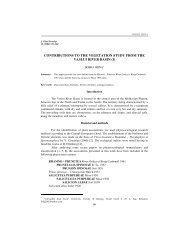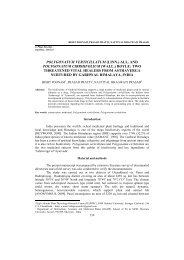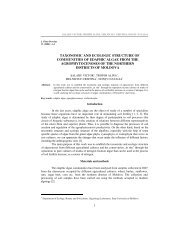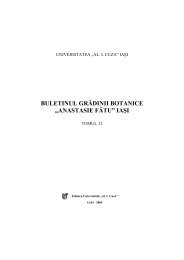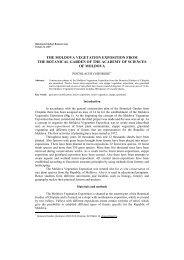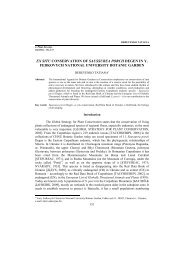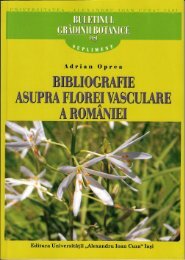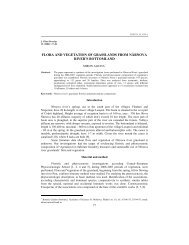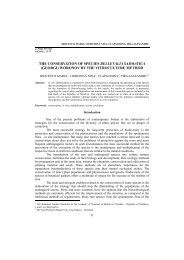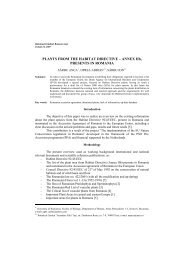importance of mushroom colections used for mycology knowledge
importance of mushroom colections used for mycology knowledge
importance of mushroom colections used for mycology knowledge
Create successful ePaper yourself
Turn your PDF publications into a flip-book with our unique Google optimized e-Paper software.
IMPORTANCE OF FUNGAL COLLECTIONS FOR MYCOLOGY IN THE FRAME OF …<br />
(2) collections with dry materials, including dried specimens from: plants,<br />
rocks, other substrates, dried cultures, microscopic preparations, coloured plastic files,<br />
drawings, pictures, preparations <strong>for</strong> studies concerning ultrastructure etc.<br />
A dried collection is a part from an Herbarium (q.v.), but <strong>mushroom</strong>s are not<br />
plants and they have to be preserved in a different way. The word „herbarium” <strong>used</strong> <strong>for</strong><br />
mycological collections is not correct, but it is using by International Mycological Institute<br />
Kew, UK. Usually, we use this word as herbarium / mycological collection / exsiccata.<br />
The in<strong>for</strong>mation concerning to deposits into both types <strong>of</strong> mycological collections<br />
is more <strong>of</strong>ten found in databases which are accessible <strong>for</strong> all persons who are interested in<br />
this domain.<br />
Abbreviations <strong>used</strong> by the most important collections are keeping during a long<br />
period <strong>of</strong> time, even the name <strong>of</strong> some institutions were been changed. There<strong>for</strong>e, some <strong>of</strong><br />
the most <strong>used</strong> abbreviations are:<br />
BPI – US National Fungus Collection (Beltsville, Md, USA), founded in 1869, as<br />
part <strong>of</strong> United States Department <strong>of</strong> Agriculture (USDA), Agricultural Research Service<br />
(ARS);<br />
DAOM – Canadian National Mycological Herbarium (Ottawa, Canada), founded<br />
in 1929, as part <strong>of</strong> Centre <strong>for</strong> Land and Biological Resources Research, Agriculture<br />
Canada; CCFC – genetic resources collection;<br />
IMI – International Mycological Institute Kew, Surrey, UK: Imperial Bureau <strong>of</strong><br />
Mycology 1920-1929; Imperial Mycological Institute 1930-1947; Commonwealth<br />
Mycological Institute 1948-1985; CAB International Mycological Institute 1986-1990, part<br />
<strong>of</strong> CABI Bioscience, from 1992, at Egham, Surrey, UK;<br />
K – Royal Botanic Gardens Kew, Surrey, UK, founded in 1841;<br />
L – Oderzoekinstituut Rijksherbarium/Hortus Botanicus, founded in 1575, which<br />
is a part <strong>of</strong> Leiden University (Holland).<br />
LE – Komarov Botanical Institute, St. Petersburg, Rusia, founded in 1714, by<br />
Academy <strong>of</strong> Science from Russia;<br />
UPS – Botanical Museum, Uppsala University, Sweden, founded in 1785;<br />
UPSC - genetic resources collection.<br />
Collections <strong>of</strong> living materials have acronyms elaborated by International<br />
Association <strong>of</strong> Plant Taxonomy which are – usually – kept and recognized by all<br />
specialized publications.<br />
In 1890, František Kral organized in Prague, the first collection <strong>of</strong> bacteria and<br />
fungi from all around the world, which existed until 1911. Un<strong>for</strong>tunately, many <strong>of</strong><br />
microorganism taxons were lost [STOICA, VASSU & SĂSĂRMAN, 2002].<br />
Referring to the most important collections from Europe, recognized by the whole<br />
world, are collections from: International Mycological Institute, Great Britain and<br />
Centraalbureau voor Schimmelcultures (CBS), now Centre <strong>of</strong> Mycological Biodiversity,<br />
from de la Utrecht University - Holland (placed <strong>for</strong>merly in Baarn, Holland).<br />
The reference collection from IMI (International Mycological Institute) Great<br />
Britain is characterized by following aspects:<br />
– databases which including host distributions and variability <strong>of</strong> taxons, and where are<br />
registered all permanent results <strong>of</strong> the most recent studies concerning cariotype,<br />
chromatographic and electrophoresis pr<strong>of</strong>iles;<br />
– studies concerning phylogenetic relationships, based on biological molecular<br />
techniques, PCR / DNA sequence etc.;<br />
112



